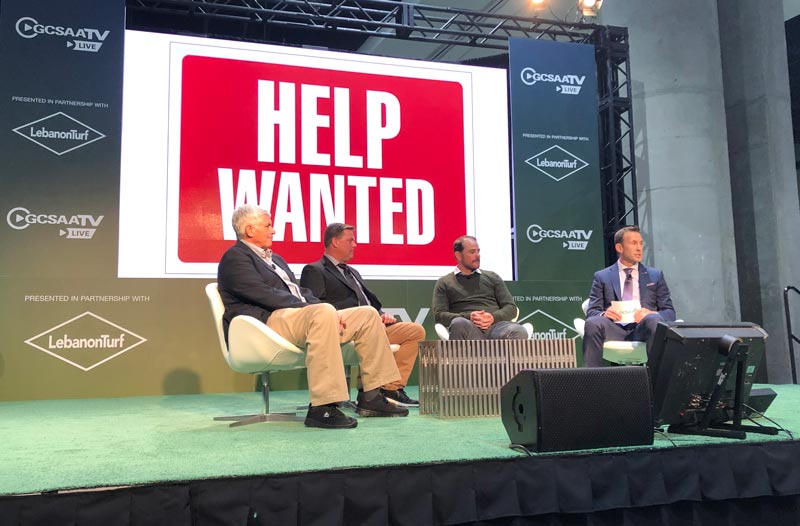
From left: Superintendents Matt Shaffer, John Thompson and Patrick O’Brien and GCSAA CEO Rhett Evans during “Help Wanted: Creative Staffing Solutions for Your Golf Course” Feb. 6 at the Golf Industry Show. Photo by Roger Billings
Matt Shaffer tried to attract staff any way possible.
“I had a guy come to us once who answered an ad in the paper,” said Shaffer, whose career as a superintendent included a long stay at famed Merion Golf Club in Ardmore, Pa., where he hosted the 2013 U.S. Open. “He was a high school teacher in Louisiana who came up here in the summers to visit an aunt. He saw the ad, and he started working for us in the summer for a few years.”
That man who taught eventually came to love working on a golf course and is currently a superintendent. Nowadays, though, not many people seem to read newspapers, and even with so many other avenues for reaching the masses, securing enough qualified golf course crew members is as challenging as ever.
Seven years ago, a GCSAA survey found that 19 percent of superintendents said they were having a difficult time recruiting labor. By last year, that number had risen to 63 percent. The number of college students endeavoring to make golf course management a career has declined in recent years, and while GCSAA CEO Rhett Evans said there have been some positive signs on that front recently, it isn’t enough to stand still and simply hope the numbers increase.
“We need to do a better job explaining how fun it (working at a golf course) really is,” said Evans, who hosted an event at the 2019 Golf Industry Show on Wednesday titled “Help Wanted: Creative Staffing Solutions for Your Golf Course.” Evans was joined on the GCSAA TV Stage on the GIS trade show floor by Shaffer; Patrick O’Brien from Hyde Park Golf and Country Club in Cincinnati; and John Thompson from Sycamore Hills Golf Club in Fort Wayne, Ind.
The foursome discussed innovative ideas that superintendents might investigate to try to address hiring issues, including recruiting retirees, veterans and different groups of young people. One avenue is the youth organization Future Farmers of America (FFA), a national program with which GCSAA has engaged and appears to be making inroads, with some of the students showing interest in future careers in golf. More than 669,000 students are members of FFA. “They work outside, work with their hands, and they grow something. They’re starting to say, ‘Count me in,’” Evans said.
Another possibility that GCSAA has looked into is the PaYS program, which helps veterans prepare for careers post-service by connecting them with employers.
In any case, it has come down to getting creative to fill more industry positions.
“You’ve got to think outside the box,” said Shaffer, who was never shy about visiting business offices when he worked as a superintendent to see whether the people working inside were truly satisfied with their jobs. “I’d say, ‘Do you enjoy sitting in this cubicle?’ or ‘You could work outside, become a superintendent and possibly make six figures,’” said Shaffer, who even approached a group of women runners about coming to work on the golf course for $15 an hour. He ended up hiring some of them, and, “I later got some of their kids to work for me,” he said.
Thompson, meanwhile, has developed a high school program in which students who come work for him get a letter grade for their efforts, similar to how they get grades in school subjects.
For Shaffer, all of this recruiting, coaxing or whatever you want to call it should be right in a superintendent’s wheelhouse. And the time is now to attack the issue with vigor. “We ought to be able to sell to people why they should work for us. We’re can-do people,” he said.
Howard Richman is GCM’s associate editor.